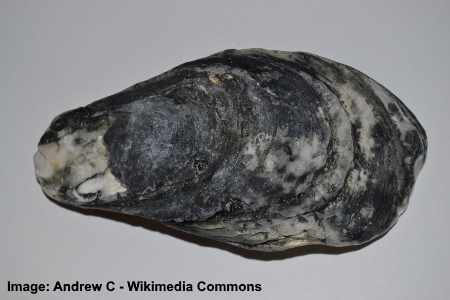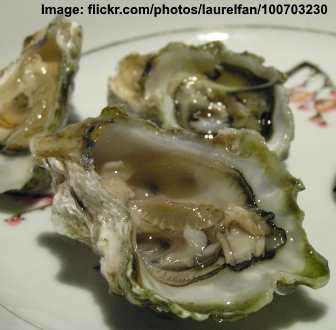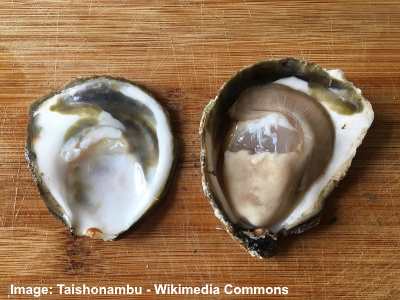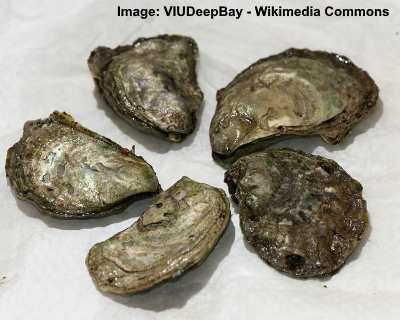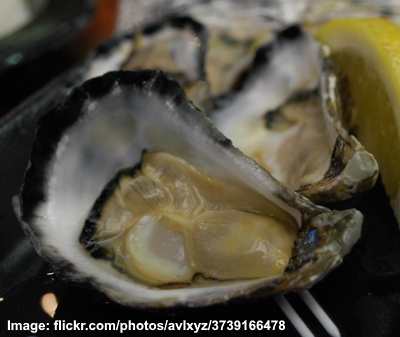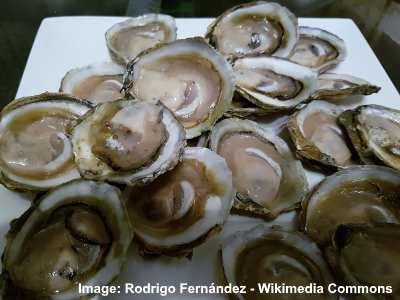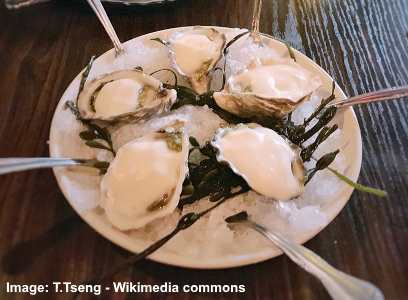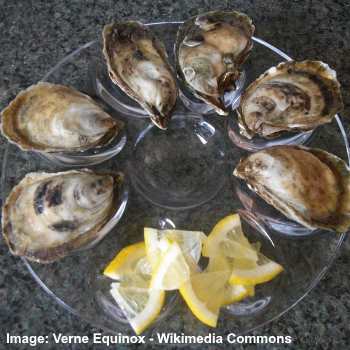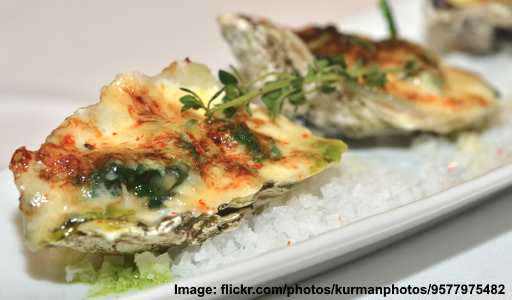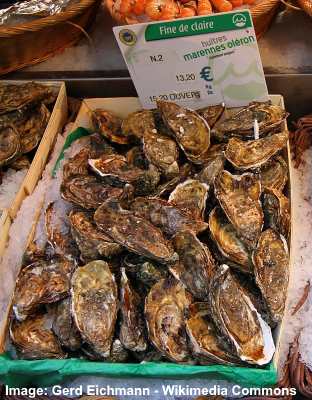Types of Oysters with Their Flavor and Picture (The Complete Guide)
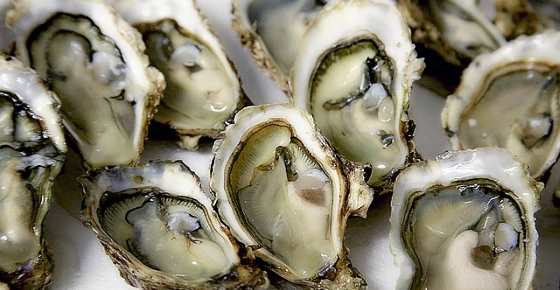
Oysters are a seafood delicacy enjoyed by people all over the world. If you are looking to buy oysters to eat, you will find that they are not all grouped under one general name. There are many varieties of oysters, all with their own unique taste, texture, and size. The common names of oyster species generally come from the seas where they are harvested. Pacific oysters (including blue point oysters, Shigoku oysters and Kumiai oysters), Japanese oysters, and Atlantic Eastern oysters are some of the most popular types of oysters.
True oysters are a type of saltwater mollusk (phylum Mollusca). Most species of edible oysters belong to the superfamily Ostreoidea. These shellfish thrive in marine or brackish habitats where the water is relatively shallow. Oysters are identified by their irregularly-shaped, flat shells that cover the soft edible inside.
Oysters are generally consumed raw or cooked. To eat fresh raw oysters, only a squeeze of lemon juice and a sprinkling of cayenne pepper is enough to enjoy this tasty delicacy.
All species of oysters also play an important role in marine ecosystems. Oysters act as water filters and one oyster can filter up to 50 gallons (190 l) of water a day. They improve water nutrient levels and they benefit the biodiversity in oceans and seas.
In this article, you will learn about the many varieties of oysters that you can eat. You will find out about the sweetest and best types of oysters to eat raw.
Types of Oysters With Their Picture and Name
Although some people find eating raw seafood unappetizing, they are a delicacy enjoyed by many people around the world.
Let’s look at some of the most popular varieties of oysters.
Pacific Oysters (Crassostrea Gigas)
Other names for Pacific oysters include Japanese oysters or Miyagi oysters. As the names suggest, these oysters grow and are farmed on the Pacific coasts of the United States and Japan. Their scientific name “gigas,” meaning giant, refers to the size of these large edible oysters.
Pacific oysters grow on rocks or mud-sand bottoms in depths of between 16 and 130 ft. (5 – 40 m) in cool waters. Being a large species of oyster, these salty mollusks grow to an average size of between 3” and 6” (8 – 15 cm). However, some of the larger oyster specimens can grow to a huge size of 12” (30 cm). They have a hard, solid shell that is a whitish color and rough feel to it. It takes between 2 and 4 years for them to reach maturity. (1)
The oysters are native to Japan and grown on coastal shores on the West Coast of the U.S., and they have been exported to other countries. They are popular in the waters around the United Kingdom, New Zealand, and Australia.
According to some reports, Pacific oysters are one of the most popular species of oysters in the world.
What do Pacific oysters taste like? The meat of the oyster is smooth and velvety. These are generally sweet oysters with creamy overtones and a slight earthiness. Compared to Atlantic or Eastern oysters, these oysters aren’t as briny.
Atlantic Oysters (Crassostrea virginica)
Atlantic oysters are also identified by names such as the American oyster, Wellfleets, Blue points, Eastern oyster, or the Totten Inlet Virginica. This oyster species is native to North America and was first discovered in the Chesapeake Bay in Maryland. Interestingly, the name “Chesapeake Bay” literally means “Great Shellfish Bay.”
Eastern (Atlantic) oysters grow fast and thrive in saltwater temperatures of between 60 and 60°F (15.5 – 20°C). They are similar in size as Pacific oysters with the smallest ones measuring 3” (8 cm) and larger varieties 7” (18 cm). Their hard calcium shells are a white or gray/brown color with some purple streaks. Inside, the shell is white and the white flesh has a purple or red-brown margin. They are generally found in shallow coastal waters and estuaries. (2)
Although native to the Eastern Coast of the U.S., these large oysters also grow along coasts in Northern Europe.
Atlantic oysters aren’t as sweet tasting as the Pacific varieties. They have a distinct saltiness that has strong flavors of the sea. Some say that Atlantic oysters have creamy hints of seaweed and mushrooms. Due to being a cold-water variety of oyster, the oyster meat is slightly crispy.
The flavors of Atlantic oysters also vary depending on where the mollusks were harvested. Many of the common names of this species refer to the areas in the U.S. For example, oysters called Blue points are Atlantic oysters from Long Island and Wellfleets are from Cape Cod, Massachusetts. The Kumiai oysters are also a type of Pacific oysters that are grown in Vizcaino Bay, Baja California,
Kumamoto Oysters (Crassostrea sikamea)
Kumamoto oysters are native to Japan and the coastal regions of countries in the western Pacific Ocean. These small sweet oysters are closely related to the Pacific oyster and have irregularly shaped rough hard shells.
Compared to Pacific oysters which grow to an average of 4” (11 cm), Kumamoto oysters only grow to 2” (5 cm) in size. Some species of “kumies” can be even smaller. They have a deep fluted shell that protects the firm oyster meat inside. The shell can be a whitish-green color. The meat is ivory-white with a dense, soft texture and hints of briny flavor.
This species of oyster is such a delicacy that they are usually labeled as “Kumamotos” oysters to distinguish them from Pacifics. These warm-water oysters are usually the first type of oysters that ‘beginners’ try. Their small size and sweet taste without any fishiness make them the perfect oyster to begin with.
Kumamoto oysters are also prized among oyster connoisseurs for their delicious, fruity flavor, and bowl-shaped shells. If you are looking for the sweetest type of oyster, then choose a Kumamoto.
European Flats (Ostrea edulis)
European flat oysters get their name from the flat pear or oval-shaped shells that protect the muscle meat. These saltwater mollusks are native to Europe and are recognized by common names such as Belon oysters, mud oysters, or Colchester native oysters.
Compared to Pacific and Atlantic oysters, this European species has a salty taste that has copper or metallic overtones. Their shallow, ridged shell is another way to identify this species from other varieties of oysters.
European oysters are an important species of farmed oysters in many coastal economies. It takes about 2 or 3 years for the oysters to reach maturity. They grow to between 1.5” and 4” (4 – 10 cm) across and the hard shells can be a yellowish or cream color. The oyster meat ranges in color from pale gray to creamy white. The inside of the shells is pearly-white. If left to grow, Ostrea edulis oysters can reach sizes of up to 7.8” (20 cm). (3)
If European oysters are named and marketed as “Belon Oysters,” they must come from the Belon River in France. So, although some producers call their oysters “Maine Belon Oysters,” these aren’t true ‘Belons.’
Shallow oyster shells hold the large meaty oyster muscle. This oyster meat has a tender to firm texture. Its taste is described as metallic and coppery with a flavor that makes a large statement. Compared to “Pacifics” or “Atlantics,” European oysters have a less salty taste and still retain some sweetness.
Due to their firm texture, European oysters are good for cooking with and are good ingredients for fish soups, stews, or making baked stuffed oysters.
Olympia Oysters (Ostrea lurida / conchaphila)
Olympia oysters are native to the northwest coast of North America. Common names of this species of oyster also give clues as to where they are harvested. For example, Olympia oysters are from Washington and they are also called California oysters. These oysters are also sold as Native oysters or Rock oysters.
There is also some confusion if they are the species Ostrea lurida or Ostrea conchaphila. These species of oysters are so similar in shape and taste that they are difficult to tell apart. The Olympia West Coast oysters are found in British Columbia and are mainly farmed in the Puget Sound.
One of the distinguishing features of Olympia oysters is that they have a distinct oval that is sometimes almost round shape. This is in contrast to pear or tear-shaped large Pacific oysters. Similar to European Belons, this oyster species has a shallow shell. The shell’s color is light purple or black and sometimes has a grayish appearance.
For many oyster connoisseurs, Olympia oysters are a delight. The oyster meat is light olive green to ivory white in color and has a creamy texture. The small amount of oyster meat packs a punchy salty flavor that has coppery mineral overtones. In fact, the taste is so reminiscent of European oysters that they are sometimes called “baby Belons.”
Sydney Rock Oysters (Saccostrea glomerate)
Sydney rock oysters are native to Australia and New Zealand. Because of this, they are also called New Zealand rock oysters or Auckland oysters. These hard-shelled mollusks thrive in shallow waters, sheltered bays, and estuaries. Unlike some of their oyster cousins in the Northern Hemisphere with rough irregular shells, these oysters are known for their smooth shells.
Sydney rock oysters are a small oyster species that are between 2” to 3” (5 – 8 cm) in length. Cutting open the shells, you will notice that the meat is pale white or yellowish in appearance. They also have a creamier and sharper mineral taste to other types of popular oysters. Sydney rock oysters also have a less briny taste to Pacific oysters but still retain a mild-sweet flavor.
Dredge Oysters (Ostrea chilensis)
Another type of true oyster native to the Southern Hemisphere is the dredge oyster. Because this species of mollusk is native to Chile, it is also called the Chilean oyster.
A common name for the Ostrea chilensis in New Zealand is the Bluff oyster. This is one of the most famous New Zealand shellfish. These oysters are harvested in the Foveaux Strait in the South Island region. Their name comes from the town of Bluff where the fishery is located. (4)
The hard oyster shells are a dull purple-brown color and have a rounder shape. One shell is ridged and bowl-shaped and the other is flatter. Shucking the oyster with an oyster knife reveals creamy colored oyster meat with hints of gray. The average size of dredge oysters is between 2.3” to 3.1” (6 – 8 cm).
The creamy delicate oyster meat is described as having meaty sweetness with hints of seaweed and mild saltiness.
Shigoku Oysters
These oysters are shaped like a mussel and were released in 2009. Shigoku oysters are a type of Pacific oyster from Willapa Bay and Samish Bay, Washington State. They have a firm meat with sweet and briny taste. They are up to 3″ (7.6 cm) in size.
This oyster is one of the best tasting oysters and has many fans, and its name reflect it – Shigoku means “ultimate” in Japanese.
Other Types of Oysters
Pacific oysters, Atlantic oysters, and European flat oysters are some of the world’s most popular mollusks. Depending on different regions of the world, there are some other varieties of oysters that are worth trying.
Beausoleil Oysters
Beausoleil oysters grow in the cold waters off the coast of New Brunswick, Canada. These are a small type of Atlantic oyster (Crassostrea virginica) that grow to about 2.5” (6.3 cm) long in 4 years.
These Atlantic oyster species have whitish-beige and gray shells and tasty firm meat. They have a sweet flavor with nutty overtones and you can also taste the sea in each morsel. If you have never tried oysters before, many oyster experts recommend starting off with a few Beausoleil oysters.
Misty Point Oysters
Misty point oysters are another type of Atlantic oyster that has a loyal following. They have a hard shell and an elongated oval shape. They are from the Barrier Islands Virginia and grow up to 3” (7.6 cm).
What is the flavor profile of Misty Point oysters? They have a distinct briny taste of the sea with earthy flavors. The meat is creamy and pleasantly firm.
Wellfleet Oysters
Wellfleet oysters are a famous type of oyster harvested around the estuaries of Wellfleet, Massachusetts. The waters around this area of the Atlantic create the perfect environment for high-quality oysters.
The cold waters help the oyster grow a firm meaty muscle scar and this results in a distinctly sweet flavor compared to other oyster species. Also, the high salinity and large tides result in a salty-tasting, hardy type of oyster that stays fresh for a long time.
Fine de Claire
In Europe, one of the finest types of oysters you can try is the Fine de Claire variety. This is a hard-shelled mollusk with an elongated shape and ranks among the superior European oysters. The reason why these are top quality oysters is that they are finished in salt ponds. This gives the delicious salty oysters a sweeter and fruitier flavor than many other species of oysters.
How to Buy the Perfect Oyster
Oysters are generally consumed raw and because of that, it’s important only to buy the best quality oysters available.
How can you pick out the freshest, sweetest, and most delicious oysters? Here are a few helpful tips.
- Supplier. If possible, always buy oysters directly from a reputable seafood supplier or fish market rather than a supermarket which is the middleman. This helps to ensure freshness.
- Check the smell. You should make sure that there is no pungent or “funky” smell from the oyster. A reputable seller will open up an oyster for you to check if there is any odor. If you open up an oyster at home and there is an unpleasant smell, don’t eat it.
- Don’t buy from tanks. Buy fresh oysters that are kept on ice rather than in water tanks. Putting the oysters in a tank washes all of the brine out of the oyster. Not buying oysters from tanks ensures you get the delicious brine when you open the oyster and you can enjoy all the wonderful tastes of the sea.
Related articles:


